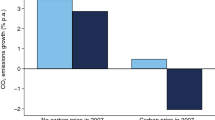Abstract
This study undertakes a systematic analysis of calculated time-series carbon emissions data from Anhui province, China, between 1999 and 2012; it also presents relevant measurement models by which to predict the carbon emissions of Anhui province from 2013 to 2015. We found that given current rates of growth, total emissions would increase by up to 37.47 %. Furthermore, this study quantitatively analyzes the influence factors pertaining to Anhui province’s carbon emissions. The results show that population effects on increases in carbon emissions have declined gradually, and that increased energy consumption has promoted a reduction of carbon emissions; it was also found that carbon emission intensity has stimulated an increase in carbon emissions to a degree larger than population effects have. Economic development, additionally, has stimulated an increase in carbon emissions. This study also puts forward some measures by which to reduce carbon emissions in Anhui province, and they involve improvements to the energy structure, an increase in energy efficiency, and a strong focus on high-energy-consumption and high-emission industries.





Similar content being viewed by others
References
Dodman, D. (2009). Blaming cities for climate change? An analysis of urban greenhouse gas emissions inventories. Environment and Urbanization, 21(1), 185–201.
Fan, Y., Liu, L. C., Wu, G., Tsai, H. T., & Wei, Y. M. (2007). Changes in carbon intensity in China: Empirical findings from 1980–2003. Ecological Economics, 62(3), 683–691.
Fan, Y., Zhang, X., & Zhu, L. (2010). Estimating the macroeconomic cost of CO\(_{2}\) emission abatement in China based on multi-objective programming. Advances in Climate Change Research, 1(1), 27–33.
Hammond, G. P., & Norman, J. B. (2012). Decomposition analysis of energy-related carbon emissions from UK manufacturing. Energy, 41(1), 220–227.
Hu, Z., & Cai, W. (2007). The study on the impacts of energy intensity imposed by the taxation of energy taxes: A CGE approach. Journal of Hunan University (Social Sciences), 5, 57–61.
Intergovernmental Panel on Climate Change. (2006). 2006 IPCC guidelines for national greenhouse gas inventories, Prepared by the National Greenhouse Gas Inventories Programme. Hayama: IGES.
Krey, V., O’Neill, B. C., van Ruijven, B., Chaturvedi, V., Daioglou, V., Eom, J., et al. (2012). Urban and rural energy use and carbon dioxide emissions in Asia. Energy Economics, 34(S3), S272–S283.
Li, H., Wang, L., Shen, L., & Chen, F. N. (2012). Study of the potential of low carbon energy development and its contribution to realize the reduction target of carbon intensity in China. Energy Policy, 41, 393–401.
Li, Y. M., Zhang, L., & Cheng, X. L. (2010). A decomposition model and reduction approaches for carbon dioxide emissions in China. Resources Science, 32(2), 218–222.
Ma, C., Ju, M. T., Zhang, X. C., & Li, H. R. (2011). Energy consumption and carbon emissions in a coastal city in China. Procedia Environmental Sciences, 4, 1–9.
O’Neill, B. C., Dalton, M., Fuchs, R., Jiang, L., Pachauric, S., & Zigovad, K. (2010). Global demographic trends and future carbon emissions. Proceedings of the National Academy of Sciences of the United States of America, 107(41), 17521–17526.
Roberts, J. T., & Grimes, P. E. (1997). Carbon intensity and economic development 1962–1991: A brief exploration of the environmental Kuznets curve. World Development, 25(2), 191–198.
Song, D. Y., & Lu, Z. B. (2009). The factor decomposition and periodic fluctuations of carbon emission in China. China Population Resources and Environment, 19(3), 18–24.
Soytas, U., & Sari, R. (2009). Energy consumption, economic growth, and carbon emissions: Challenges faced by an EU candidate member. Ecological Economics, 68(6), 1667–1675.
van Vuuren, D. P., Deetman, S., van Vliet, J., van den Berg, M., van Ruijven, B. J., & Koelbl, B. (2013). The role of negative CO\(_{2}\) emissions for reaching 2 \(^{\circ }\)C—Insights from integrated assessment modelling. Climatic Change, 118(1), 15–27.
Wang, Q. W., Zhou, P., Shen, N., & Wang, S. S. (2013). Measuring carbon dioxide emission performance in Chinese provinces: A parametric approach. Renewable and Sustainable Energy Reviews, 21, 324–330.
Wang, R., Liu, W., Xiao, L., Liu, J., & Kao, W. (2011). Path towards achieving of China’s 2020 carbon emission reduction target—A discussion of low-carbon energy policies at province level. Energy Policy, 39(5), 2740–2747.
Yao, C., Chen, C., & Li, M. (2012). Analysis of rural residential energy consumption and corresponding carbon emissions in China. Energy Policy, 41, 445–450.
Zhang, X. P., & Cheng, X. M. (2009). Energy consumption, carbon emissions, and economic growth in China. Ecological Economics, 68(10), 2706–2712.
Zhang, L. X., Wang, C. B., & Song, B. (2013). Carbon emission reduction potential of a typical household biogas system in rural China. Journal of Cleaner Production, 47, 415–421.
Zhang, J., Zhang, Y., Yang, Z., Fath, B. D., & Lia, S. (2013). Estimation of energy-related carbon emissions in Beijing and factor decomposition analysis. Ecological Modelling, 252, 258–265.
Zhou, P., Ang, B. W., & Han, J. Y. (2010). Total factor carbon emission performance: A Malmquist index analysis. Energy Economics, 32(1), 194–201.
Acknowledgments
We appreciate the support of the Program for New Century Excellent Talents in University (No. NCET-12-0595), the National Natural Science Foundation of China (Nos. 71171001 and 71222106), the Humanity and Social Science Youth Foundation of Ministry of Education of China (No. 10YJC630208), the Key Foundation of Natural Science for Colleges and Universities in Anhui, China (No. KJ2011A001), the Soft Science Foundation of Anhui, China (No. 12020503063), and the Key Foundation of National Research in Statistics of China (No. 2011LZ023).
Author information
Authors and Affiliations
Corresponding author
Rights and permissions
About this article
Cite this article
Song, ML., Zhou, YX. Analysis of Carbon Emissions and Their Influence Factors Based on Data from Anhui of China. Comput Econ 46, 359–374 (2015). https://doi.org/10.1007/s10614-014-9456-5
Accepted:
Published:
Issue Date:
DOI: https://doi.org/10.1007/s10614-014-9456-5




